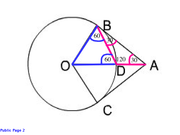
Since OB and OD are radii, OB=OD, as illustrated by the BLUE SEGMENTS in the figure above.
Thus, ∠OBD = ∠BDO.
Since it is given then BD=DA -- as illustrated by the PINK SEGMENTS in the figure above -- ∠BDA = ∠BAO.
A radius drawn to a point of tangency forms a RIGHT ANGLE.
Thus, radius OB and tangent BA form a right angle, implying that ∠OBA = 90.
We can PLUG IN THE ANSWERS, which represent the value of ∠BAO.
When we satisfy the constraint that ∠BDA = ∠BAO and that ∠OBD = ∠BDO, the result must be that ∠OBA = 90.
D: 45
Since ∠BDA = ∠BAO and ∠OBD = ∠BDO -- and ∠BDA and ∠BDO must sum to 180 -- the following figure is yielded:

Here, ∠OBA = 90+45 = 135.
Eliminate D.
B: 30
Since ∠BDA = ∠BAO and ∠OBD = ∠BDO -- and ∠BDA and ∠BDO must sum to 180 -- the following figure is yielded:

Here, ∠OBA = 60+30 = 90.
Success!
The correct answer is
B.
Private tutor exclusively for the GMAT and GRE, with over 20 years of experience.
Followed here and elsewhere by over 1900 test-takers.
I have worked with students based in the US, Australia, Taiwan, China, Tajikistan, Kuwait, Saudi Arabia -- a long list of countries.
My students have been admitted to HBS, CBS, Tuck, Yale, Stern, Fuqua -- a long list of top programs.
As a tutor, I don't simply teach you how I would approach problems.
I unlock the best way for YOU to solve problems.
For more information, please email me (Mitch Hunt) at
[email protected].
Student Review #1
Student Review #2
Student Review #3


